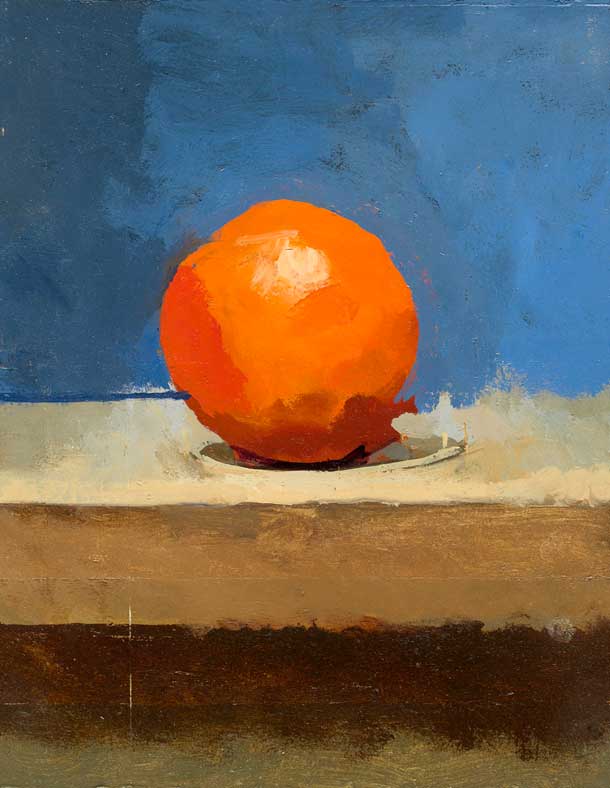
Robert Dukes, Bright Orange, 2011
By Neil Plotkin
Robert Dukes is London based painter who studied at Grimsby School of Art followed by the Slade School of Art with Patrick George, Euan Uglow, and Lawrence Gowing. Robert Dukes lectures at the National Gallery and teaches for the Prince’s Drawing School.
He has an upcoming show, Paintings and Drawings, at Browse and Darby. Mr. Dukes has been kind enough to send some images from the show and has graciously taken the time to answer a few questions about himself and his work.
Neil Plotkin: You studied at Grimsby School of Art and later at the Slade. What was the impact, inspiration, and/or pressure that you felt because of the reputation (or hype?) associated with your instructors and fellow students.
Robert Dukes: Grimsby and the Slade could not have been more different. The was no pressure at Grimsby, partly as I had no clue of what to expect, but also because of the atmosphere of the school created by its Head- a great man called Peter Todd, and its teachers. When I arrived there age 16 I had no idea about art- I was making superficial photographic illustrations. Peter Todd and my tutor Nev Tipper never once tried to push me towards fine art, even though they both believed it was what I should be doing. They let it happen naturally, which took about a year and a half (I was there three years in total). If they had tried to push me I would have resisted and I have no idea what I’d be doing with my life now.
After Grimsby the Slade was a huge disappointment to me. To try and explain the difference: If you set up your easel in the corridor at Grimsby School of Art, it was because you wanted to paint the view out of the window. If you set up your easel in the corridor at the Slade, it was because you wanted people to see you painting the view out of the window.
On a more positive note, I did have extraordinary people as tutors- Lawrence Gowing, Patrick George, Euan Uglow. But I didn’t fit into the life room ethic for a number of reasons:- I didn’t like the sycophantic behaviour of the students towards Euan Uglow (although I respected him very much). My hero at the time was Frank Auerbach. Also, at Grimsby we used to paint one picture a day, and seeing students spend ten weeks on one life-painting (at the Slade) seemed pretentious.
To summarise: Grimsby was a wonderful experience and set me on my path as a painter: The good things from the Slade came after I’d left, for instance my friendship with Euan Uglow.
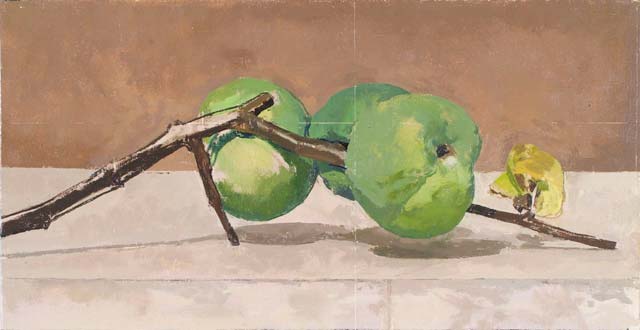
Green Quinces 2004
(click for larger view – true for all the images in this article
NP: How would you depict the different phases or objectives of your work throughout your career, and what are the themes or motivations that keep pushing your work forward?
RD: I went to the Slade hoping to be inspired and excited but it had the opposite effect. I left in 1988 and did almost no painting for the next ten years or so. I kept drawing the whole time though.
Also, I had to earn a living and as a result I had little time to paint. When I did paint I felt that I had no control over the forms I was trying to depict- and that had the effect of making me not want to paint, which of course meant that when I did paint, I was out of practice so it inevitably went badly.
The turning point for me was the painting of a coffee mug (1998). I started to measure from the mug because I couldn’t get it to work any other way. I also felt that I’d managed to make equivalents for the tonal shifts across the cylindrical surface of the mug. Finally, a realised image as opposed to the gestural paintings I’d been producing up to that point. Over the next few years I gradually introduced coloured objects into the paintings. Things really started moving around 2001, when I got my own apartment with space to paint in.
Regarding themes: I get excited looking at things and it makes me want to paint them.
As far as motivation goes, who knows what really motivates us? And perhaps best not to think too hard about it. Having wasted years floundering, I just want to fulfill some kind of potential. Also, there is a long list of favourite painters at the end of this questionnaire and the fact that they are all much greater artists than me drives me on to try and paint better pictures.
NP: For this show you have included some of the works that you painted from masters’ paintings. This work has a somewhat different feel from some of your directly observed work – they seem simultaneously more careful and more expressive. The work looks more layered and more experimental with color choices, in particular the painting after Balthus. Can you talk a little about what your thought process was and what these works mean for you in the context of your overall work.
RD: In context of my work overall… I’m not sure. I do think making copies is a good excuse to spend a long time looking at a painting you admire.
Recently the painter Patrick George spoke to me about my painting after a Corot landscape: “I like that, because when you copy someone else, I can see where you are heading with your own work.” Which was very insightful, because of course what he also meant without saying it was, “but your work from observation still looks too much like Uglow’s”.
The Balthus copy, when I was doing it, I was copying as objectively as I could, or at least I thought I was… when I look at it now, three years later, it doesn’t look so straightforward.
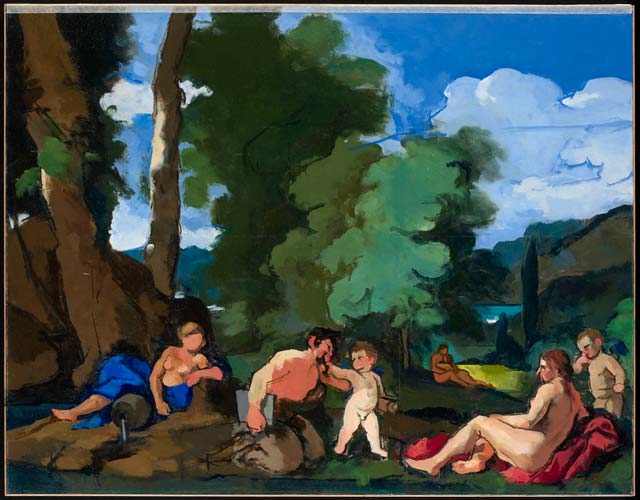
Amor Vincit Omnia, after Poussin, 18 x 24 inches
NP: You lecture at the National Gallery. When I’ve spoken to other artists, I’ve found that their extracurricular activities have a real role and impact on their art. How does lecturing play a role in your own work?
RD: Yes I lecture at the National Gallery but I also worked in the gift shop there for fifteen years. The National Gallery is like the centre of the world to me. Being in there, whether it’s lecturing, teaching, drawing from the paintings, or “just” looking, repeatedly reminds me of what real painting is.
NP: The art critic Andrew Lambirth has said “What is remarkable about [you] paintings is that they look so full of life and vigour even though subjected to such strict procedural disciplines.” Does this comment strike a chord with you, and if so can you talk about what your procedural disciplines are and what your reasons are for utilizing the ones you’ve chosen?
RD: Yes! It really does strike a chord. It’s marvellous when someone “gets” your work like that. It’s especially important to me because one reason I didn’t utilize such “strict procedural disciplines”(read: ”take lots of monocular measurements”) when I was at the Slade, was partly because I think that most painters that do measure a lot, their work looks tight and lifeless. I measure in order to give myself freedom to organize my thoughts.
NP: You currently teach at the Prince’s Drawing School. Obviously drawing is important to you. How does it play a role in the creation of your work? Do you create drawings and studies before painting?
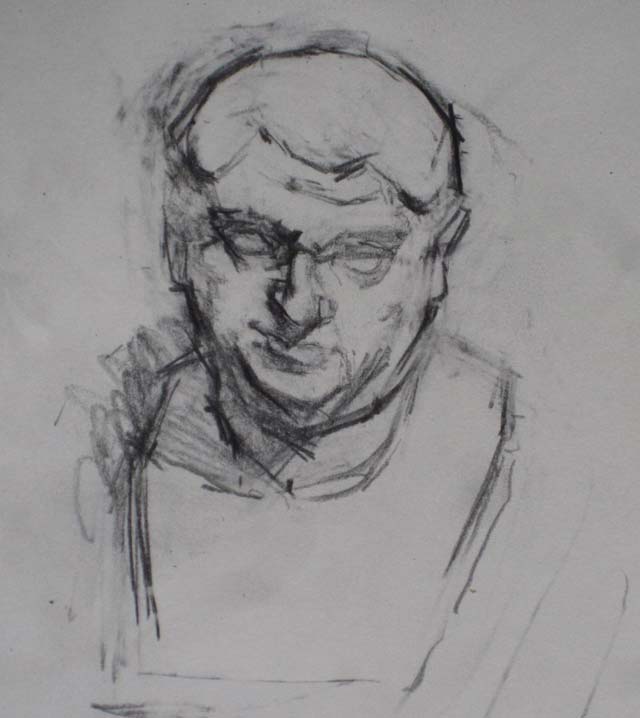
“Vitellius, in the Walker Art Gallery”, 2010, 4 7/8″ x 4 1/4″
RD: I draw in the morning before I start painting- it’s a way of waking up and getting my eye-in. If I don’t draw before painting I tend to mess the painting up. However the drawings I make have no direct relation to my paintings; they’re usually copies made from reproductions. I rarely make studies for my paintings, maybe because the compositions are so simple.
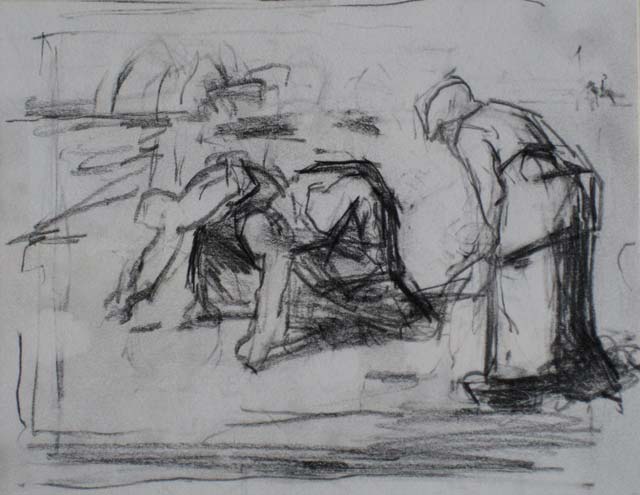
The Gleaners, after Millet, 2011, 4 1/2″ x 5 3/4″
The classes I teach for the Prince’s Drawing School are based in the National Gallery and the Victoria and Albert museum, drawing from art. It’s wonderful to teach because it ticks so many boxes: the students improve their drawing, learn about composition, art history etc. etc., but most importantly, even if their drawing is a mess at the end of a session, for a few hours they’ve had the experience of really engaging with great art. Drawing is the best way of looking at art.
NP: The representation of space in your work varies immensely – from the very tight and small spaces of the candies in Allsorts to the large open space of Balleroy Village. Do you have a preference for a particular type of space in your paintings?
RD: One reason that I almost stopped painting during the 1990’s was the feeling that I had no sense of proportion or control over the space of what I was depicting. Single – often monochrome- objects, were a simple means with which to tackle these problems.
Also, when I got “back into” painting in the late nineties, I was working full-time in the National Gallery shop, and time was at a premium- so one of the main reasons I started to paint still-lives was expediency- the “model” is always willing to pose for you! For the same reason I usually paint by electric light: it’s consistent, even at 5 o’clock on a December afternoon.
I’m aware that my work often falls into the category of what Myles Murphy would refer to as “single object painting”. I don’t like this limited aspect to my work- it’s something I want to address in the near future. For instance I would really like to paint more landscapes… “Balleroy Village” was painted on a trip to Normandy with the Prince’s Drawing School. Landscape for me is the opposite of “single object painting”.
NP: Who are some artists (past or present) whose work really excites you?
RD: To begin in the present:- My favourite living artists- the ones whose work I’m always excited to see- are Leon Kossoff, Frank Auerbach and Patrick George.
But before I give you my list of favourite painters: I just wanted to say that almost everybody I’ve taught has something personal and engaging in their work- and often the students that claim that they “can’t draw” produce the most exciting images of all. Anyway, here’s the list:-
Victor Pasmore, William Coldstream, Euan Uglow, Claude Rogers, Patrick Symons, Giorgio Morandi, Richard Diebenkorn, Gwen John, Graham Sutherland, Picasso, Braque, Matisse, Nicolas de Stael, Bonnard, Vuillard, Giacometti, William Scott, Roger Hilton, Robert Motherwell, Jackson Pollock, Balthus, Joan Eardley, Keith Vaughan, Dubuffet, Cezanne, Seurat, Corot, Pissarro, Degas, Delacroix, Ingres, Gericault, Courbet, Van Gogh, John Constable, Manet, Goya, Chardin, Gabriel de St.Aubin, Thomas Jones, Hogarth, Stubbs, Rembrandt, Poussin, Claude Lorraine, Adriaen Coorte, Carel Fabritius, Velazquez, Rubens, Vermeer, Hals, Titian, Veronese, El Greco, Tintoretto, Masaccio, Piero della Francesca, Carpaccio, Giovanni Bellini, Antonello da Messina, Sassetta, Fra Angelico, Ercole de Roberti, Simoni Martini, Duccio, Giotto.

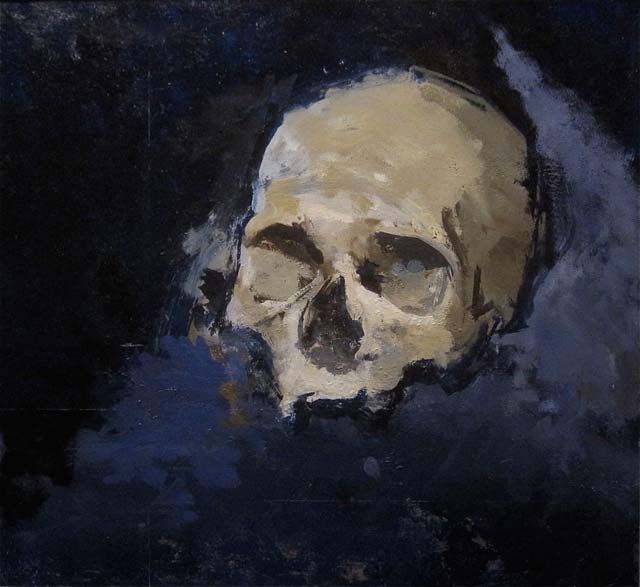

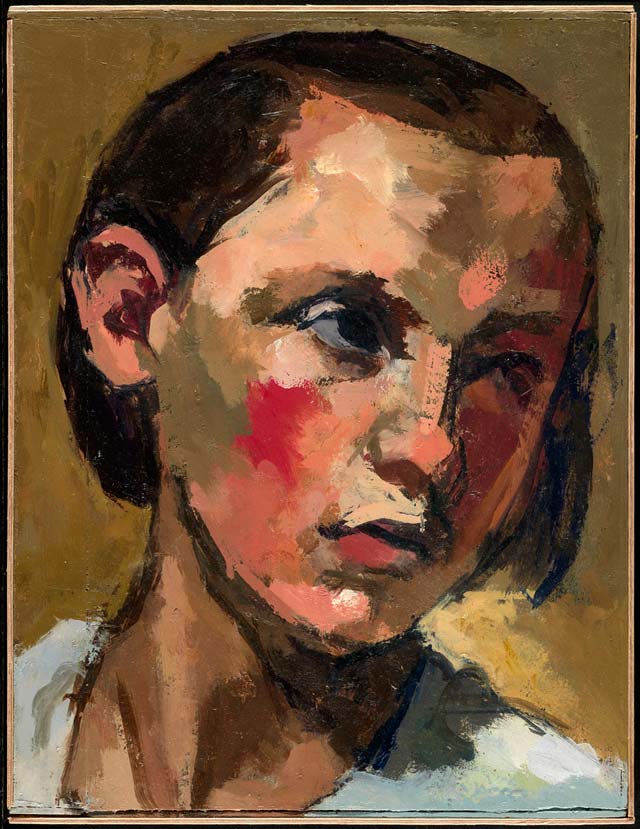
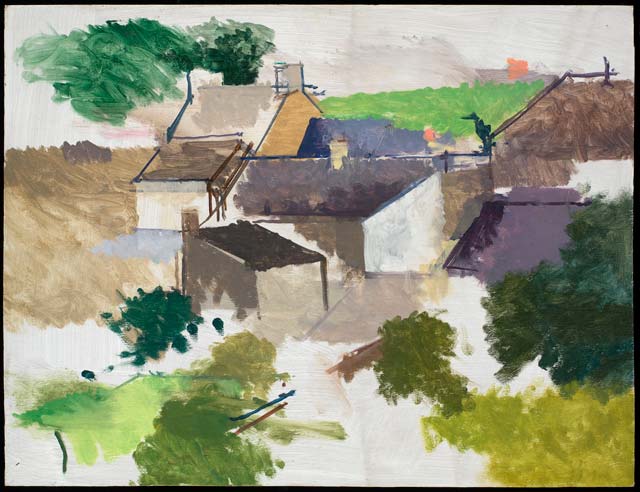
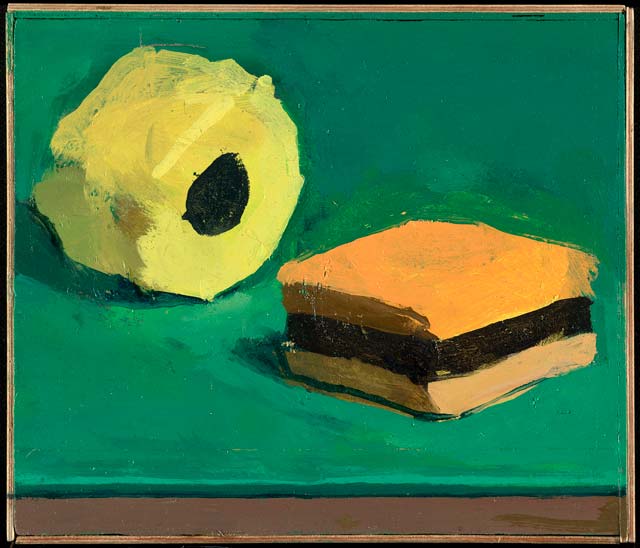
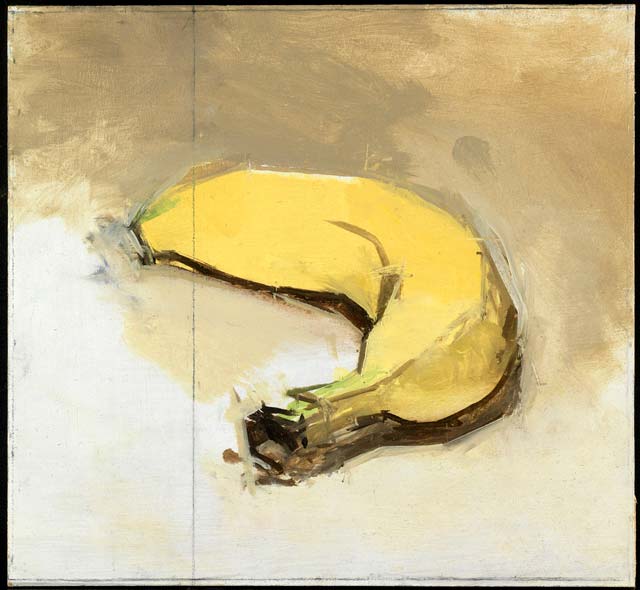
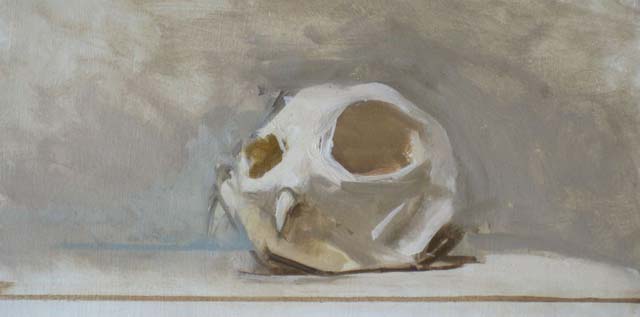
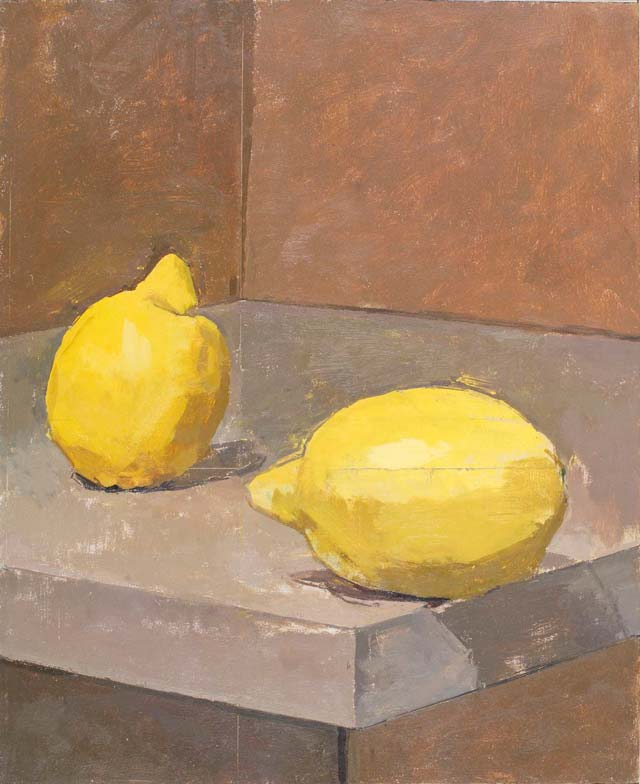




What an insightful and honest interview with Robert Dukes. I really appreciate the concentration on one or two objects in a painting, even it is often due to time constraints. When one works with a simple set up, one can find lots of variation in those small spaces, and great power. Dukes finds both, along with the shimmering glow of a Giotto. I’m looking forward to seeing those jewel like colors in his future landscapes.
very nice interview and thoughtful responses. I remember seeing one of his pieces at Browse and Darby last summer, a small still-life of an orange, and liking it very much. I would have to agree with his statement: “drawing is the best way of looking at art”…it seems like all the great artists of the past, relentlessly copied the ‘old masters’…Cezanne, Van Gogh, Giacometti, to name a few….a sure-fire way of figuring out how to organize paint. Thanks for the introduction to a hard-working, seeking artist, Neil.
I saw Robert’s show last night at Browse and Darby. I was in London seeing a friend of mines show at the Medici and both galleries were having a PV. Piers Ottey was taught my Myles Murphy and new some of Roberts mentors. I’ve been aware of Roberts work for a few years, ever since his last one man show and the sad demise of Uglow. I love the fluidity of the painting, they are not as locked down or a deadpan as a Uglow and have a kind of surface that looks “hard won” (a reference to a a key show at the RA when i was a student) and layered. I’d like to know how many other paintings lie beneath each still life?
I love the absurdity of painting liquorice all sorts, why not, I’m currently painting pomegranates and limes!
Yesterday, I went to the summer exhibition, and my favourite painting was of a banana. Just one! I just couldn’t work out what was so special about this particular painting. So here I am on this website and I very much like Robert Dukes work, and he sounds such a nice man!
Rob, I enjoyed your recent show. It was lovely seeing your new work which I like very much.
Rob,I also had the privelege to be taught by Mr Todd and Nev Tipper.I still remember vividly the crackle and energy of their teaching, and in my case astonishing patience!But also,I had the further bonus of having you as one of my peers and I can confess after nearly 28 years(surely not!!!)that I was fairly in awe of your furious concentration and dedication and would always pour over your drawings whenever you left the room!I still blush with shame at how I used to copy you !(Imitation is the highest form of flattery they say.Thats my excuse anyway!).So,here I am now.Still admiring your work and also inspired by your comments in the interview.(Ps-after a long lapse I was finally able to thank Mr Todd, at a Corot exhibition,for all he taught me.My fawning was brushed off in the usual brusque fashion!Fair brought a tear to my eye!).Great to see you’ve not lost that keen eye Rob.Your paintings show a ‘single object’can have the intensity of an icon.Thankyou.
Hi Robert
After Balthaus – a dynamic and stunning work – the marks – large passages expressed with one colour (after dare I say it – Uglow – maybe??), fast painting, moving.
I like Robert Duke’s paintings very much. In this interview he shows that the life of an artist is not a straight line. The ups and downs and detours are very informative.
I’m glad to hear you took up the brush again..
Can anyone tell me how these drawn lines on Roberts work come about?They look as-though they are scratched in with the point of a compass or something.What are they about?
Also how does he prepare the boards he paints on ,what are they made of and how are the edges applied and where are they made?
Thank you
David
Great an honest answers,humble sounding and modest rally exciting artist,there’s feeling in the work and Iike the small scale.its as conte part as Gary Hume but more painterly way surpassing’popart ‘Will be important work in the history of art for future generations.Only I wish paintings could have a more profound effet on the disk tag ration and destruction man is rapidly imposing on himself and the Earth.I wonder why art and museums are really so important?
Great and honest answers,humble sounding and modest ,
exciting artist,there’s feeling in the work and I Iike the small scale.its as contemporary as Gary Hume but more painterly way surpassing’popart ‘Will be important work in the history of art for future generations.Only I wish paintings could have a more profound effet on the disk tag ration and destruction man is rapidly imposing on himself and the Earth.I wonder why art and museums are really so important?ll
What is it that isn’t so straight foward about the Balthus copy seen three years later One wonders?
Hi Robert, I can only echo the previous comments and find your work inspirational. I also studied at Grimsby Art School, but in my leisure time. The tutors were the same and my particular guru was Nev Tipper. Such an easy going guy who ensured you were on the right track but without you knowing it. This was of course to let you have the “wings” to develop your own way. I attended in the period 1972 until about 1985 and also studied engineering whilst working as a marine engineer. I was fortunate to have as a peer Melvyn Petterson who has remained a friend since and now has a print studio and workshop called artichoke in London the south I think.
Grimsby had such an impressive reputation which we both experienced and now so many decades later I now work at the Grimsby Institute (formally the Grimsby College) as a business advisor. Other notables were Kenny King, with whom I grew up, Steve Newton who I also grew up with and is now professor of fine art at Newcastle University. Another tutor I remember is Alf Ludlam who has since retired. There are two galleries now in Grimsby Abbey Gate and The Gate Gallery both achieving impressive exhibitions of artists both past and present. The cherry on the cake so to speak are the national exhibitions which bot have managed to secure for Grimsby. I will continue to follow your work with interest.
What a wonderful interview. I love when he said, “I measure in order to give myself freedom to organize my thoughts.” His drawings and paintings feel free, but the drawing is right. I’m excited to see what he paints in the future.
I have attended a course with Robert at the London art academy recently and it was brilliant.He was so generous and so one hundred percent there for his students.
Talking shop all day.It was so refreshing to be around him .He will exude information for as long as you can listen.Sometimes I had to zone out because it was overload and wish I could have been more capable to take more in.But all this has stayed with me and I am still drawing from that reservoir now and will be probably for years to come.
Thanks Robert.
these paintings and the colors make my heart soar!!!! and it’s so encouraging even without training — thank you so so much.
I too was delighted by Robert Dukes interview. Before I left Grimsby three years ago I was attending the art school for evening classes. One of my companions was Peter Todd’s wife Janet who in her nineties was still going to London to give music lessons.. I would like to know of any practical teaching sessions Robert is giving.